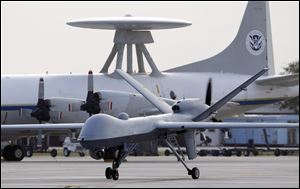
ALL BUT 1 AMERICAN EMBASSY OPEN
U.S. keeps heat on in Middle East
Drone strikes kill militantsamid shifting terror threat
8/12/2013
A Predator B unmanned aircraft taxis at the Naval Air Station in Corpus Christi, Texas. The growing reliance on drones in Yemen suggests the limit of resources the United States can employ in combating the new threats.
WASHINGTON — U.S. diplomatic outposts reopened throughout the Middle East on Sunday, easing the sense of imminent danger that has preoccupied the Obama Administration since it learned of a possible terrorist attack from communications between two al-Qaeda officials almost two weeks ago.
The one embassy still closed — in Sanaa, Yemen’s capital — underscored the challenges President Obama faces in winding down the nation’s decade-long campaign against al-Qaeda and its associates and reshape counterterrorism strategy.
In response to the latest threat, the United States has unleashed a barrage of drone strikes in Yemen. But it is unclear to what extent it has reduced the threat from an increasingly decentralized al-Qaeda organization.
Recently, U.S. officials have expressed heightened fears about an emerging al-Qaeda affiliate in Syria; prison breaks in Pakistan, Libya, and Iraq that have set free hundreds of potential terrorists; an apparent inability to arrest Libyan suspects indicted in the lethal attack on the U.S. mission in Benghazi last year, and a new haven in southern Libya for extremists across North and West Africa.
“Terrorists now have the largest area of safe haven and operational training that they’ve had in 10 years,” John McLaughlin, an ex-deputy director of the Central Intelligence Agency, told a security forum last month.
President Obama acknowledged these challenges Friday, noting that while al-Qaeda’s core leadership in Pakistan had been “decimated,” the terrorist group has “metastasized into regional groups that can pose significant dangers.”
He insisted this development did not contradict his assertion in May that the struggle against terrorism had changed fundamentally.
In that speech at the National Defense University, he offered a path to wind down the war against terrorists, a campaign against a lethal yet less able network of regional al-Qaeda affiliates launching “periodic attacks against Western diplomats, companies, and other soft targets.”
Mr. Obama said then that targeted killings needed to be tightly limited. But the growing reliance on drones in Yemen suggests the limit of resources the United States can employ in combating the new threats.
A senior U.S. official said over the weekend that the most recent terrorist threat “expanded the scope of people we could go after” in Yemen. “Before, we couldn’t necessarily go after a driver for the organization; it’d have to be an operations director,” the official said. “Now that driver becomes fair game because he’s providing direct support to the plot.”
Senior U.S. intelligence officials said last week none of the three dozen militants killed so far by drones were “household names,” meaning top-tier leaders of al-Qaeda in the Arabian Peninsula. But the U.S. official said the strikes had targeted “rising stars” in the Yemen network.
“They may not be big names now,” the official said, “but these were the guys who would have been future leaders.”
The strikes’ effectiveness is unclear. And that’s not the only obstacle U.S. officials must confront in the aftermath of the Arab Spring.
Security analysts note many of the Arab spy services the United States had relied on in places such as Egypt, Tunisia, and Yemen have been upended in the political turmoil, robbing the CIA and U.S. intelligence of long-trusted allies in their fight against terrorists. “U.S. intelligence has drastically lost its influence over Arab intelligence partners as a consequence of the Arab Awakening and, more worryingly, its intelligence-probing capability,” said Magnus Ranstorp, research director of the Center for Asymmetric Threat Studies at the Swedish National Defense College in Stockholm.
“Without a longer-term U.S. strategy that builds capacity in key countries, counterterrorism is effectively reduced to tackling the superficial symptoms and to putting out perpetual terrorist fires,” he said.